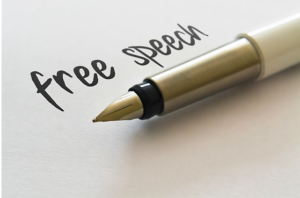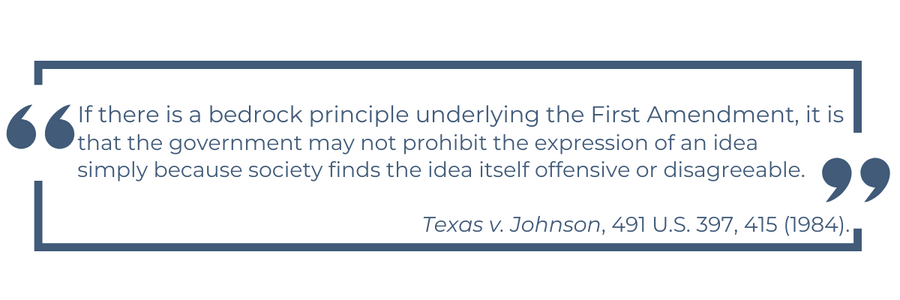First Amendment Attorney in Ohio

Among the protections in the First Amendment to the U.S. Constitution is freedom of expression—the right to “free speech.” This freedom takes many forms. It might be the right to protest, to criticize the government, to engage in unpopular speech, or the rights of a free press. Whatever form your expression takes, if the government tries to censor your speech or punish you for exercising your constitutional rights, contact a First Amendment attorney at Bolek Besser Glesius today.
If nothing else, the First Amendment means government may not censor or punish speech because it doesn’t like the ideas expressed. The right to free speech is not absolute though. As most people know, free speech doesn’t protect things like “falsely shouting fire in a crowded theatre.”
The First Amendment is one of the most complex areas of constitutional law. It often requires the help of an experienced First Amendment attorney to determine whether there is a free speech violation.
What type of speech does the First Amendment protect?
The First Amendment protects many types of speech. The core of what it protects is political speech, particularly speech critical of the government. As the Supreme Court has held, the First Amendment reflects our “profound national commitment to the principle that debate on public issues should be uninhibited, robust, and wide-open.” New York Times v. Sullivan, 376 U.S. 254, 270 (1964). That means the First Amendment protects even “vehement, caustic, and sometimes unpleasantly sharp attacks on government and public officials.” Id.
At the other end of the spectrum, the First Amendment offers no protection at all to some types of speech. There are a few narrowly limited categories of speech the Supreme Court has deemed so harmful to society that they are unprotected from government regulation. They include inciting others to imminent lawless action, fighting words, true threats of violence, obscenity, child pornography, and defamation.
The difficulty with First Amendment law is that free speech issues often fall somewhere between these two ends of the spectrum. In a society as complex as ours, these issues arise in countless ways. Some of the emerging areas in free speech law include:
- Student speech and speech on college campuses;
- Free speech on the internet;
- Public employee speech and whistleblowers;
- The free speech rights of protesters; and,
- Freedom of the press.
Is controversial or unpopular speech protected?
Though it’s not always clear when speech is protected, what is clear is that the government may not prohibit speech because it is unpopular or offensive. The Supreme Court has explained that “[i]f there is a bedrock principle underlying the First Amendment, it is that the government may not prohibit the expression of an idea simply because society finds the idea itself offensive or disagreeable.” Texas v. Johnson, 491 U.S. 397, 415 (1984).
 It might seem counterintuitive to protect unpopular or even hateful speech. But that is when freedom of speech is at its most critical. If we want freedom for the speech we like, we must protect it for the speech we hate. Otherwise, freedom of speech is no right at all.
It might seem counterintuitive to protect unpopular or even hateful speech. But that is when freedom of speech is at its most critical. If we want freedom for the speech we like, we must protect it for the speech we hate. Otherwise, freedom of speech is no right at all.
Without a doubt, protecting hateful and offensive speech comes with some societal costs. Even so, that is a cost we must bear “in order to provide adequate breathing space to the freedoms protected by the First Amendment.” Boos v. Barry, 485 U.S. 312, 322 (1988).
If you have been targeted by the government because your ideas are unpopular or controversial, speak with a First Amendment attorney to see if the government has stepped over the constitutional line.
What is a content-based restriction on speech?
Courts use a variety of tests to decide whether government has violated the First Amendment, and which test a court will use depends on context. Still, there are a few guiding principles in the free speech analysis.
One of the central factors in free speech cases is whether government regulation of speech is “content-based” or “content-neutral.” Content-based regulations are those in which the government discriminates against speech because of its topic or the message it conveys—i.e., the content of what is expressed. On the other hand, content-neutral laws apply to all speech regardless of what is said; these regulations are unrelated to the content of the expression.
To understand the difference, consider a government regulation banning all yard signs in front of houses. Because it applies to all yard signs regardless of topic, the law is content-neutral. Now imagine the government banned only political yard signs. That law would be content-based; it applies only if the message expressed concerns a particular topic.
The distinction matters a great deal. Content-based regulations must meet a very high bar to pass muster, known as “strict scrutiny.” Except under rare circumstances, a speech regulation subject to strict scrutiny will fail. Content-neutral laws are often evaluated under a more deferential standard and are more likely to survive.
One type of content-based discrimination especially suspect under the First Amendment is “viewpoint discrimination.” That occurs when government restricts speech because of the particular ideas (or “viewpoint”) the speaker expresses. In our yard sign hypothetical, think about a law banning Democratic political yard signs, but allowing Republican political yard signs. That law would be viewpoint-based. Regulation of speech based on viewpoint will almost always violate the First Amendment.
First Amendment attorney fighting overbroad speech laws

Beyond the content divide, courts have used other doctrines to examine constitutionality of speech regulation.
Two related, but distinct, doctrines are known as “overbreadth” and “vagueness.” Courts sometimes use these doctrines to examine regulations that might chill protected speech. An overbroad restriction permissibly regulates some conduct or speech, but also incidentally impacts or deters otherwise-protected speech. The concept of vagueness is somewhat similar. It applies to government regulation that fails to provide fair warning of what is unlawful conduct. The test for vagueness is whether the statute would give someone of ordinary intelligence fair notice of what is outlawed.
One important Supreme Court case involving both the overbreadth and vagueness doctrines came from Ohio. In Coates v. Cincinnati, 402 U.S. 611 (1971), the Court struck down a Cincinnati ordinance making it a criminal offense for three or more people to assemble on a sidewalk and “conduct themselves in a manner annoying to persons passing by.” The Court held the law was overbroad because it allowed punishment of speech that—while annoying—was otherwise-protected. For example, the law could be used to punish peaceful (but loud) political protestors if onlookers found the protest annoying. The Court held the regulation was also unconstitutionally vague because it created an “unascertainable standard.” People would have to guess what was prohibited and what was not.
Do free speech protections depend on where the speech takes place?
Yet another important consideration in free speech cases is where the speech takes place.
There are essentially three different types of locations (or “forums”) in free speech cases: traditional public forums, limited or designated public forums, and nonpublic forums. Different tests apply to government censorship of speech depending on the forum. And which test apply is often outcome-determinative.
Traditional public forums are those historically open for public debate. The quintessential examples of public forums are sidewalks, streets, and parks. The government has the least ability to censor speech in a traditional public forum. Any restriction must be content-neutral unless it can survive strict scrutiny.
Another important limitation on government regulation of speech in public forums concerns reasonable “time, place, and manner” restrictions. These restrictions are those regulating when, where, and how expression takes place. A noise ordinance is a classic example. To be reasonable, the restriction must be content-neutral, must serve an important government interest, and must leave plenty of alternative means of expression available.
A limited public forum is public property that the government has opened for public use as a place for expression. An example would be a college or university meeting room. In a limited public forum, government may impose content-based restrictions only if the regulation survives the demanding strict scrutiny standard.
The final category is the nonpublic forum—government property that is not specifically designated for public debate. For instance, prisons, military bases, and schools are nonpublic forums. Government has more latitude to impose speech restrictions in these places. In a nonpublic forum, government may regulate speech based on content if the restriction is reasonable, but may not discriminate based on viewpoint.
If this all seems confusing, that’s because it is. To best protect your right to free speech, you should consult with an experienced First Amendment attorney.
Does the First Amendment protect conduct?
Of course, the First Amendment protects verbal speech and the written word. But people can express themselves without saying or writing anything. Consider, for instance, standing for the national anthem (or refusing to do so). Both send a message, but are entirely nonverbal. The question then becomes whether “freedom of speech” ever applies to conduct. The answer is “sometimes.”
The First Amendment applies to conduct if it is sufficiently expressive. The Supreme Court established the test for so-called “expressive conduct” in Spence v. Washington, 418 U.S. 405 (1974). In that case, a college student was convicted for displaying an American flag upside down in his apartment window with a peace sign affixed to it. Striking down his conviction, the Court held that the First Amendment applies to nonverbal communication if “intent to convey a particularized message was present, and in the surrounding circumstances the likelihood was great that the message would be understood by those who viewed it.”
There are limitless examples of expressive conduct. Wearing black arm bands to protest war, burning the flag, wearing clothing or buttons to convey a message, and sit-ins are all forms of conduct that courts have viewed as expression within the meaning of the First Amendment.
Ohio First Amendment attorney defending the Constitution
Freedom of speech is the core of our democracy. That said, the First Amendment does not protect all speech at all times. Figuring out whether government censorship violates the First Amendment is often a very complex question.
If you believe the federal government, State of Ohio, or a local government has violated your free speech rights, the best way to find out is to consult with an experienced Ohio free speech lawyer at Bolek Besser Glesius.

